Personal finance
Corolab Investment Guide: Long-term investing
Compounding maximum capital growth over the long term in a tax-efficient manner
Overview
People invest for the long term for different reasons. When you have time on your side, taking advantage of two
things can maximise your outcome:
- investing in a reputable fund that is managed to deliver maximum capital growth; and
- doing so in a tax-efficient manner.
The impact of compounding maximum capital growth in a tax-efficient manner over the long term is significant.
This edition illustrates how to pair the most appropriate growth-oriented multi-asset class fund with a suitable tax-efficient product to achieve two examples of long-term investment goals.
Why do you invest for the long term?
The most likely (and significant) reason people invest for the long term is to build up capital for their retirement, which could be multiple decades from now.
Those who are fortunate enough to have access to discretionary savings (in other words, savings in excess of what they are already committing to their retirement pot) may be investing for an additional long-term goal, such as a child’s education, towards having greater financial freedom later in life, or towards creating generational wealth.

Whatever significant long-term goal you aim to invest towards, it is worth remembering that you can achieve maximum capital growth tax-efficiently. Let’s start with how to maximise capital growth over the long term.
Maximising capital growth over the long term
When investing for a long-term goal, your single biggest aim is to achieve inflation-beating returns that will grow your real wealth over time. Inflation is the biggest risk to long-term investors as it steadily erodes purchasing power, meaning that the same amount of money will buy less in the future than it does today.
EQUITIES DELIVER COMPELLING REAL RETURNS OVER LONG PERIODS OF TIME
As is clear from the graph below, equities stand out as the asset class best positioned to combat inflation, thanks to its ability to generate real returns that far outpace other asset classes such as bonds and cash. Historically, based on data spanning back to 1929, South African equities have delivered 7.4% per annum (p.a.) real, whereas local bonds returned 1.8% p.a. real over the same period. Cash has barely kept pace with inflation, yielding real returns of 0.2% p.a. over this extended time period.
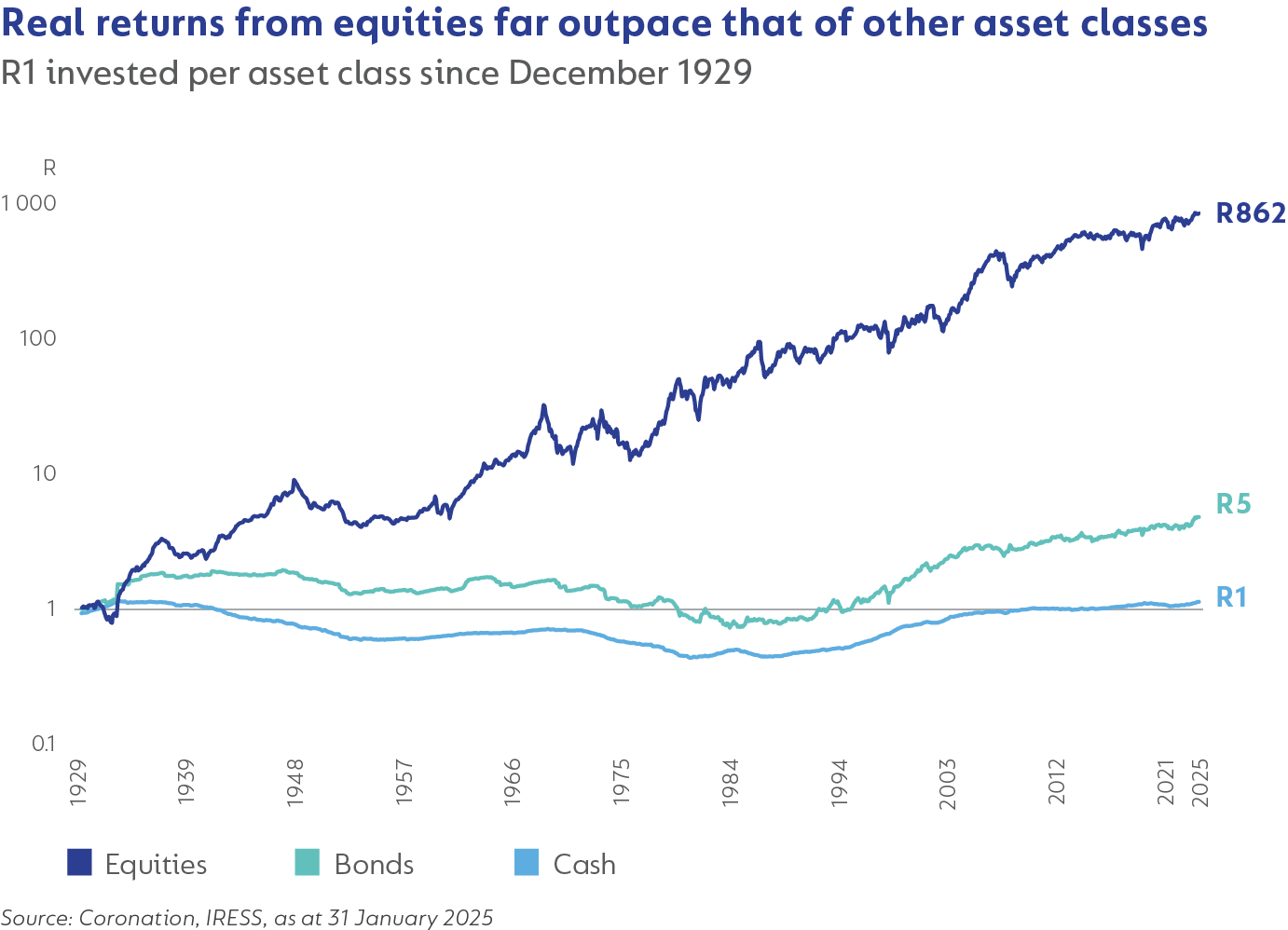
Thus, equities are essential for those aiming to build a portfolio that outpaces inflation and creates substantial wealth. They offer long-term growth potential that few other asset classes can match. By prioritising equity exposure over long periods of time, investors position themselves to achieve meaningful, inflation-beating returns.
CONSIDER GROWTH-ORIENTED MULTI-ASSET CLASS FUNDS TO STAY THE COURSE
Long-term investors could consider funds that are fully invested in equities – the asset class that provides the highest expected return over time (as demonstrated earlier).
However, being fully invested in equities (domestic or global equities, or a combination of both) comes with higher short-term volatility. While the longer you remain invested in equities, the lower this variability becomes, most investors may prefer a less volatile experience that allows them to stay the course while still achieving inflation-beating returns.
For example, Coronation’s growth-oriented multi-asset class funds aimed at retirement savers Coronation Balanced Plus or discretionary investors Coronation Market Plus have delivered attractive real returns over the past two decades (see table below).
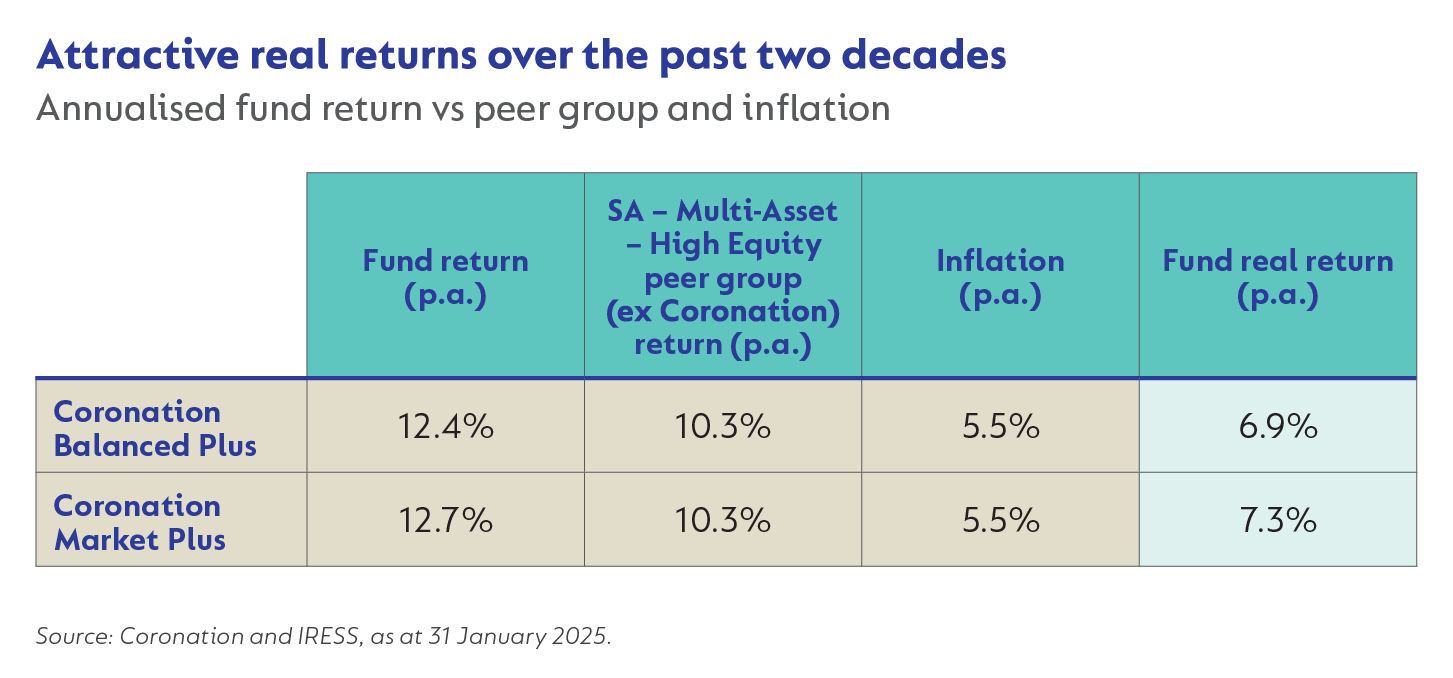
STICK WITH REPUTABLE MANAGERS WITH LONG TRACK RECORDS AND AN INTEGRATED APPROACH TO PORTFOLIO CONSTRUCTION
Delivering track records like the funds mentioned earlier, require asset allocation across all geographies and asset classes through the cycle – a capability that very few managers have.
This is because it requires an integrated approach that is anchored in a granular understanding of every single security’s risk and return dynamics and the ability to construct and manage a portfolio based on that deep knowledge.
In a world where very little goes to plan, investors need to consider investing for the long term with good asset allocators that have demonstrable track records in taking bold and decisive actions as has been required in response to the many unimaginable events of the last 20+ years.
Achieving tax-efficiency over the long-term: Two case studies
In this quest for tax-efficient investing over the long term, your options include retirement annuities (RAs), tax-free investments (TFIs), and endowments for higher-income individuals.
While each of these fulfils a different function in an investor’s overall portfolio (it’s not a case of one being better than the other), the remainder of this Corolab will focus on two case studies in which we discuss the most suitable combination of underlying investment fund (with which to maximise your capital growth) and product type (with which to achieve tax-efficiency) for the purposes of retirement investing or for another discretionary long-term goal.
CASE STUDY 1: INVESTING FOR RETIREMENT BY WAY OF A RETIREMENT ANNUITY
Maximising capital growth with Coronation Balanced Plus
If you are saving for retirement, we believe that Coronation Balanced Plus, our flagship pre-retirement fund, is the most suitable option for your retirement savings. The fund offers investors the highest exposure to growth assets and offshore exposure within Regulation 28 limits, allowing investors to maximise capital growth.
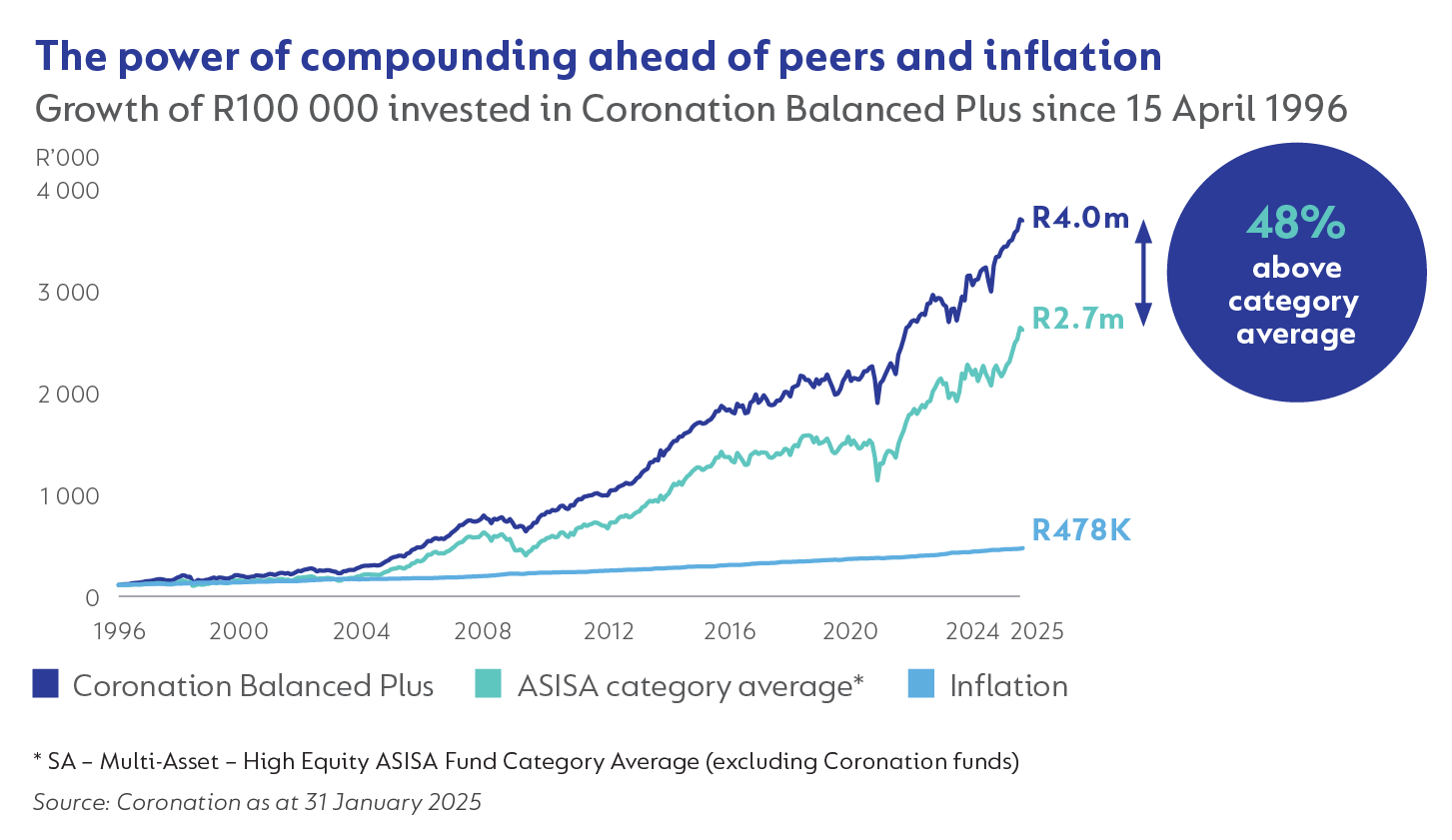
Coronation Balanced Plus has a close to 29-year track record in delivering inflationbeating returns ahead of its benchmark (ASISA category average). Since inception, the Fund also managed to outperform the local equity market, and doing so with much less exposure to equities.
This level of outperformance compounded over time, can add significantly to your investment outcome. As is clear from the prior graph, an investment in the average high equity balanced fund almost 29 years ago would have grown your capital by 27 times (in nominal terms) as at end January 2025, whereas a similar investment in the Coronation Balanced Plus Fund, which has outperformed the category average by a seemingly small 1.5% p.a. after fees, would have grown your capital by just shy of 40 times over this same period.
Achieving tax efficiency with a Retirement Annuity
The Coronation Retirement Annuity Fund is a personal retirement account that enables you to save tax-efficiently for retirement if you are self-employed or with which to supplement your existing occupational retirement savings if you are employed.

Your investment in an RA must comply with Regulation 28 of the Pension Funds Act. Investing in the Coronation Balanced Plus Fund (as discussed before) is the simplest way to achieve that using Coronation’s best investment views.
One of an RA’s key advantages is that your contributions are tax-deductible (up to certain limits). The following example best illustrates the tax saving enabled by contributing towards an RA. Investor A earns a non-retirement funding income of R500 000 a year but doesn’t contribute to an RA. As a result, Investor A pays roughly R120 000 in tax on that amount of income. Now let’s assume Investor A did contribute the maximum allowable amount to an RA, which is 27.5% of R500 000 (or R137 500). This results in a tax saving of more than R40 000, which ultimately funds 32% of Investor A’s contributions for the year.
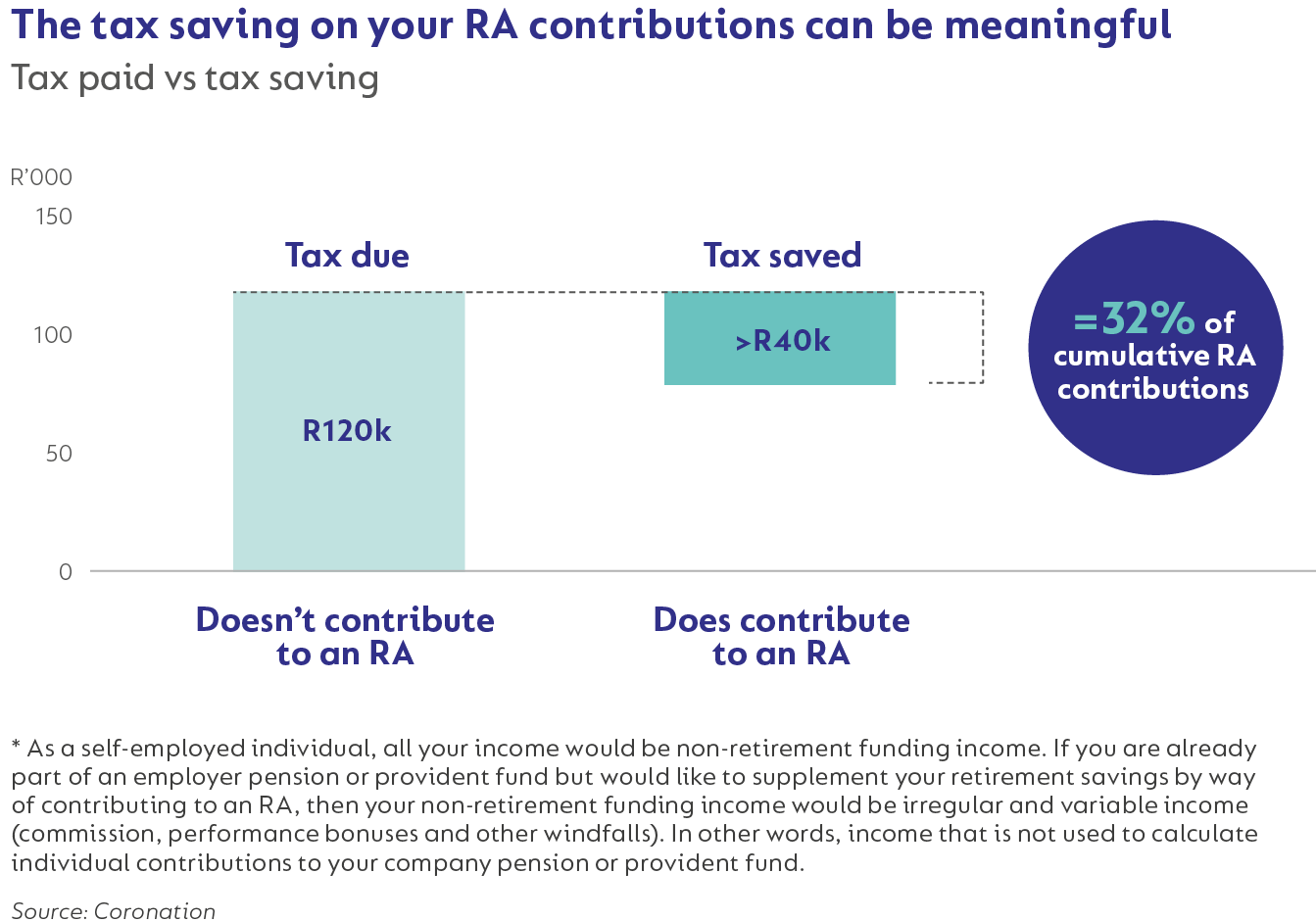
Reminder: Don’t disrupt the power of compounding tax-free growth
If you consider the other key benefit of an RA, which enables your investment returns to grow tax-free while you remain invested, the investment outcome becomes even more significant. But it’s crucial not to disrupt the power of investment growth that grows tax-free.
While the new two-pot retirement system offers investors the flexibility to access a portion of their RAs during emergencies, early withdrawals come with significant long-term financial consequences that could drastically reduce a member’s standard of living in retirement.
>Early withdrawals are taxed at a higher rate
Early withdrawals from your RA are taxed at a member’s marginal tax rate. By waiting until retirement (at age 55 or ideally later) before you withdraw, you benefit from being taxed at the preferential lump sum rates.
>Early withdrawals disrupt the powerful effects of long-term compounding
Compounding enables retirement savings to grow exponentially over time, as returns generate further returns. For instance, for every R1 withdrawn from a retirement fund 30 years before retirement, the future value of a member’s savings is reduced by around R6 in real terms, due to the opportunity cost of foregoing compounded growth. Even over shorter periods, the impact is still significant – withdrawals made just 10 years before retirement could result in an opportunity cost of R2 (in real terms) for every R1 withdrawn.
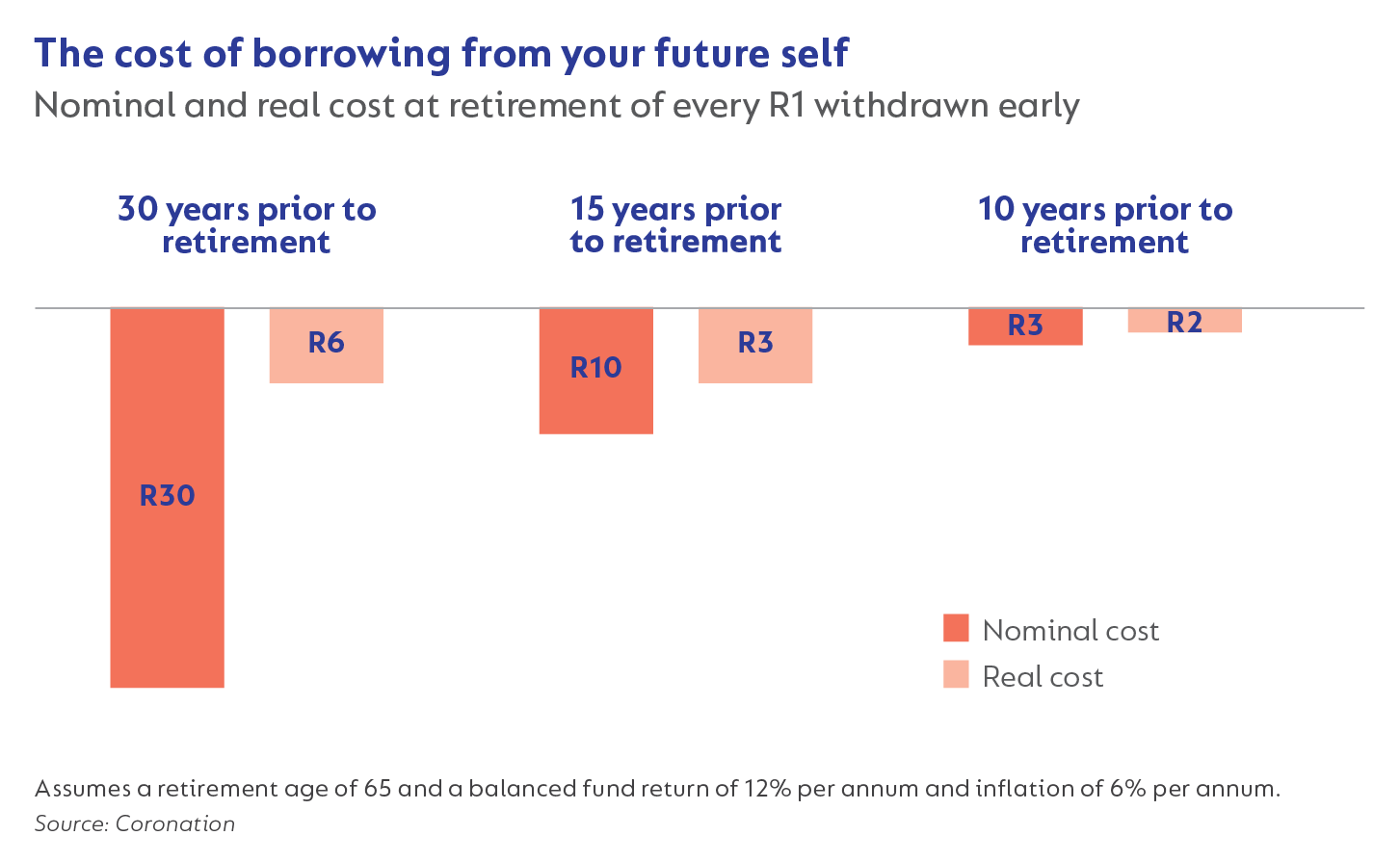
This serves as a powerful reminder that early withdrawals not only deplete the current balance but can ultimately jeopardise long-term financial security.
CASE STUDY 2: INVESTING FOR A LONG-TERM GOAL WITH DISCRETIONARY SAVINGS
Maximising capital growth with Coronation Market Plus
If you are investing for a long-term goal with discretionary savings, your options for achieving maximum capital growth are wide. Depending on the purpose of your investment, your investment fund doesn’t need to comply with Regulation 28 and could include anything from a domestic equity-only fund (such as Coronation Equity or Coronation Top 20) to a global fund available to South African investors.
We believe Coronation Market Plus offers a complete long-term solution for discretionary long-term savers. Since its inception in 2001, Coronation Market Plus has met the needs of aggressive investors aiming to build long-term capital outside their retirement portfolios. With the ability to invest more than 75% in equities (the regulatory limit under Regulation 28) and 45% offshore, Coronation Market Plus has delivered annualised returns well ahead of inflation and the average balanced fund. What is particularly pleasing is that, over this period, Coronation Market Plus has also managed to outperform the JSE All Share despite never being fully invested in equities.
Achieving tax efficiency with a Tax-Free Investment
If you want to make your discretionary long-term investment work harder, you could consider housing your chosen underlying investment fund in a tax-free investment (TFI), such as the Coronation Tax-Free Investment account.
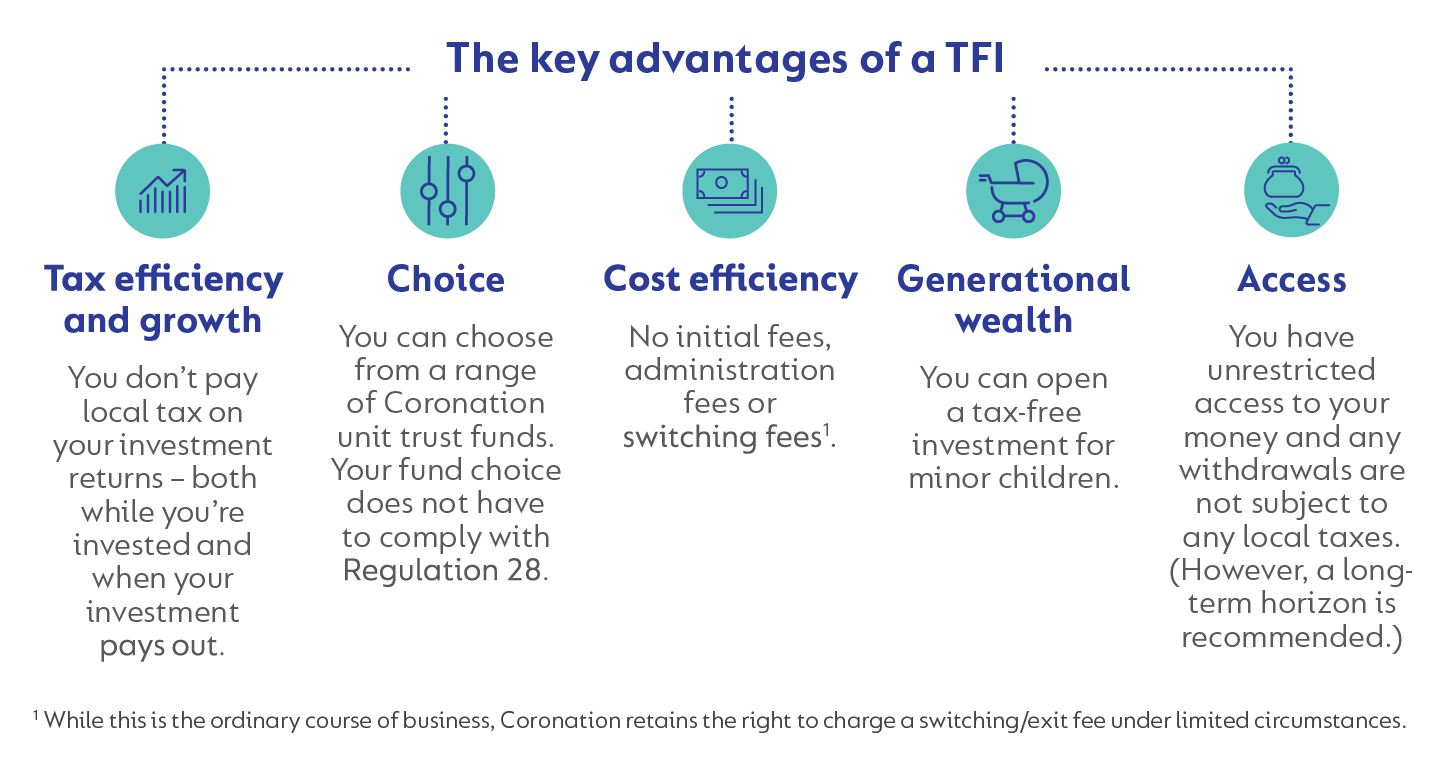
When you invest in a TFI, you don’t pay local tax on your investment returns—both while you’re invested and when your investment pays out. The taxes you save remain invested to grow, which can make a significant difference over the long term.
The following illustrative example highlights the long-term benefits of tax-free compounding in a fund such as Coronation Market Plus. Imagine that you invest the maximum annual amount (R36 000) in a tax-free investment for your child from birth. If you continue doing so, you will reach the lifetime limit of R500 000 before your child turns 14. The longer you decide to keep the money invested, the more the benefits of compounding and the greater the extent to which your tax-free fund outperforms the same taxable fund in real terms.
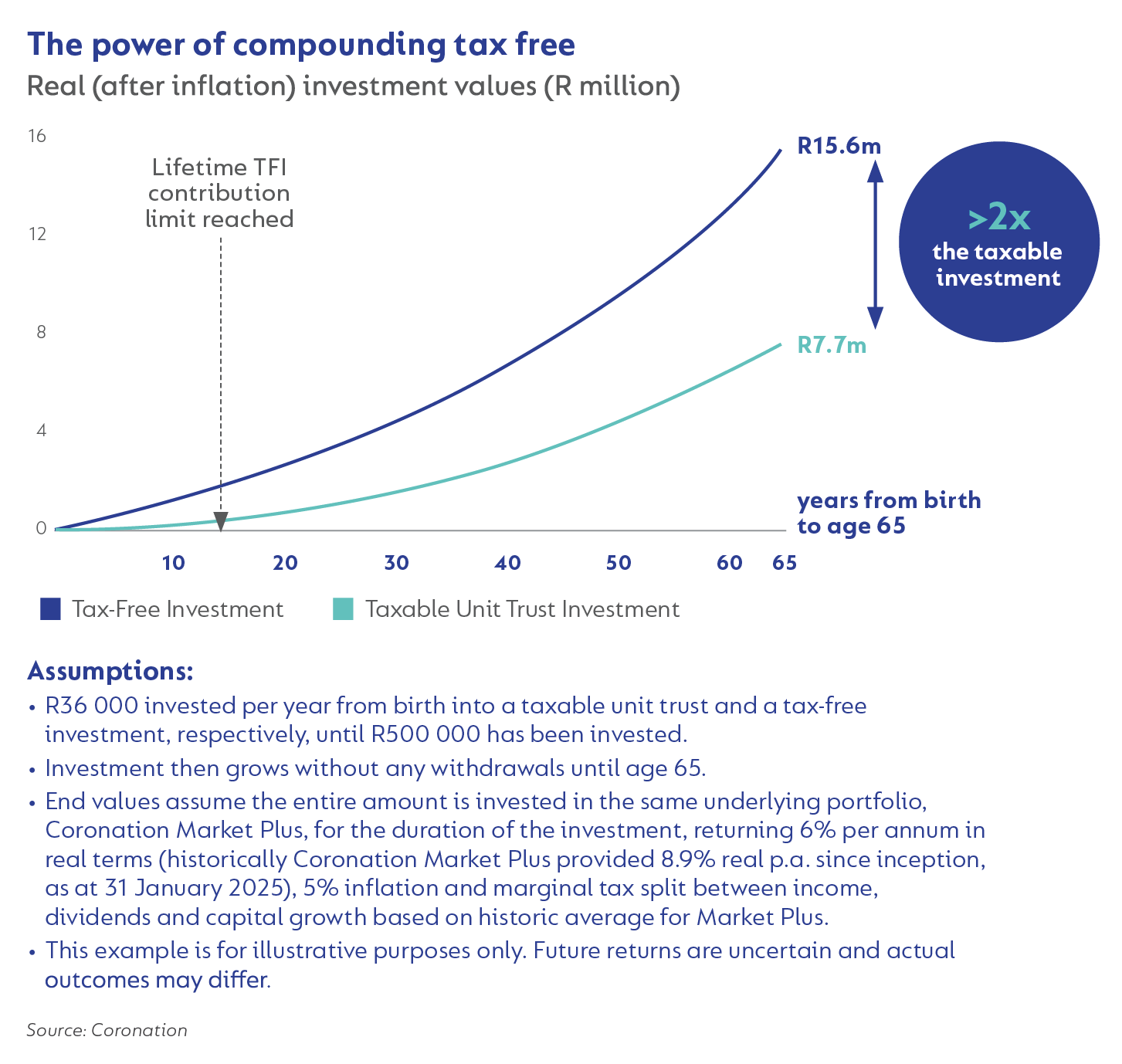
Our analysis, based on certain assumptions (as detailed in the graph above), shows that if you keep the money in the fund until your child turns 18, the value of the tax-free investment will be 21% greater than the equivalent taxable investment. By age 30, this difference widens to 41% and by age 65, the investment would be double the value of the same taxable investment. These results show that by resisting the temptation to disinvest from the fund, the nest egg built up would keep your child in good stead by either financing tertiary education, buying a first home or ideally investing in their retirement, depending on when your child decides to disinvest.
This theoretical exercise also shows the incredible power of compounding over long periods. Investing R500 000 spread out over 14 years and then doing nothing for 41 years results in an investment worth R15.6 million in today’s money by age 65. Our hypothetical (very patient) tax-free investment beneficiary would, therefore, never have to contribute to retirement while working, effectively freeing up 10% to 15% of annual income that would typically have been required to fund retirement income if you start contributing in your early 20s.
You can also select to maximise your capital growth in international markets
Investors seeking to utilise their discretionary savings in a fund predominantly investing in offshore asset classes (Coronation Market Plus is limited to 45% offshore) can consider one of Coronation’s global long-term growth-oriented multi-asset funds.
The Coronation Global Optimum Growth Fund is an aggressive allocation fund suited to investors with a very long time horizon (10 years plus). Read more about this fund in our Corolab: Investing Offshore.
A higher-income option
High-income individuals who have already hit the investment ceiling in their TFI could consider an endowment as another tax-efficient investment option.
The appeal of endowments lies in the flat tax rates that apply to income and capital gains. Income is taxed at 30% (compared with a marginal individual tax rate that can be as high as 45%), while capital gains are taxed at 12% (compared with an effective rate of 18% for individuals in the highest income tax bracket). Investors’ underlying fund options are not restricted by any regulation. As such, you can choose to invest in any of our long-term growth-oriented funds.
Conclusion
The conclusion is as simple as it is compelling: Invest for your long-term goals in reputable growth-oriented multi-asset funds with long track records in the delivery of equity-like, inflation-beating returns.
Choosing a multi-asset fund such as Coronation Balanced Plus (for savers who need to adhere to retirement limits within the context of an RA) or Coronation Market Plus (for discretionary savers who can seek more flexibility in terms of equity exposure than a Regulation 28-compliant fund) are most likely to help you achieve the best outcomes while enabling you to stay the course.
When you pair these track records with a tax-efficient product, the power of compounding will most likely do extraordinary things for you.
 South Africa - Personal
South Africa - Personal


